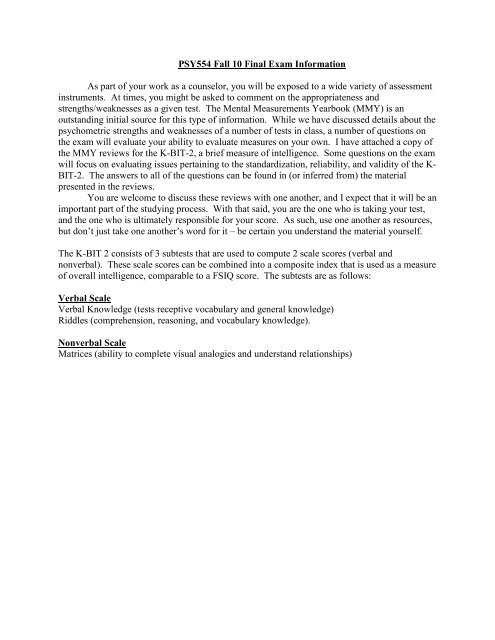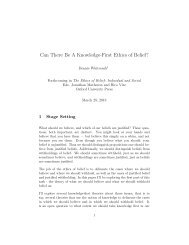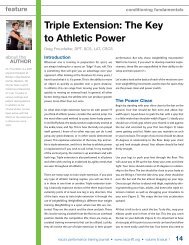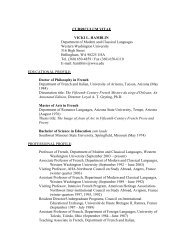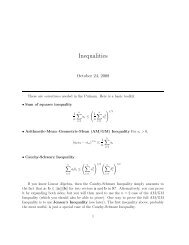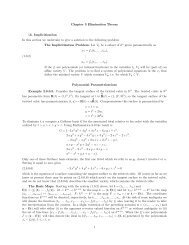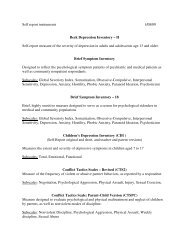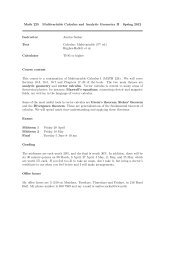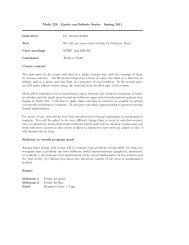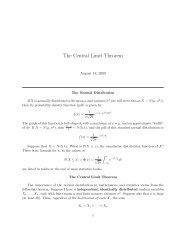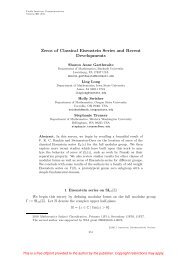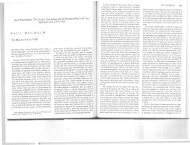Kaufman Brief Intelligence Test
Kaufman Brief Intelligence Test
Kaufman Brief Intelligence Test
Create successful ePaper yourself
Turn your PDF publications into a flip-book with our unique Google optimized e-Paper software.
PSY554 Fall 10 Final Exam Information<br />
As part of your work as a counselor, you will be exposed to a wide variety of assessment<br />
instruments. At times, you might be asked to comment on the appropriateness and<br />
strengths/weaknesses as a given test. The Mental Measurements Yearbook (MMY) is an<br />
outstanding initial source for this type of information. While we have discussed details about the<br />
psychometric strengths and weaknesses of a number of tests in class, a number of questions on<br />
the exam will evaluate your ability to evaluate measures on your own. I have attached a copy of<br />
the MMY reviews for the K-BIT-2, a brief measure of intelligence. Some questions on the exam<br />
will focus on evaluating issues pertaining to the standardization, reliability, and validity of the K-<br />
BIT-2. The answers to all of the questions can be found in (or inferred from) the material<br />
presented in the reviews.<br />
You are welcome to discuss these reviews with one another, and I expect that it will be an<br />
important part of the studying process. With that said, you are the one who is taking your test,<br />
and the one who is ultimately responsible for your score. As such, use one another as resources,<br />
but don’t just take one another’s word for it – be certain you understand the material yourself.<br />
The K-BIT 2 consists of 3 subtests that are used to compute 2 scale scores (verbal and<br />
nonverbal). These scale scores can be combined into a composite index that is used as a measure<br />
of overall intelligence, comparable to a FSIQ score. The subtests are as follows:<br />
Verbal Scale<br />
Verbal Knowledge (tests receptive vocabulary and general knowledge)<br />
Riddles (comprehension, reasoning, and vocabulary knowledge).<br />
Nonverbal Scale<br />
Matrices (ability to complete visual analogies and understand relationships)
<strong>Kaufman</strong> <strong>Brief</strong> <strong>Intelligence</strong> <strong>Test</strong> – Second Edition<br />
Purpose<br />
In Database: Mental Measurements Yearbook<br />
<strong>Test</strong> Name: <strong>Kaufman</strong> <strong>Brief</strong> <strong>Intelligence</strong> <strong>Test</strong> Second Edition<br />
<strong>Test</strong> Author: <strong>Kaufman</strong>-A; S; <strong>Kaufman</strong>-N; L<br />
Publication Date: 1990-2004<br />
Scores: Verbal, Nonverbal, IQ Composite<br />
Reviewer: Madle-Ronald-A; Shaw-Steven-R<br />
Review Indicator: 0 reviews available<br />
Publisher: AGS Publishing 4201 Woodland Road Circle<br />
Pines MN 55014-1796<br />
Acronym: KBIT-2<br />
Mental Measurements Yearbook: 17 Mental Measurements Yearbook<br />
Accession Number: 17073209<br />
Intended as a brief measure of verbal and nonverbal intelligence.<br />
Population<br />
Ages 4-90.<br />
Price<br />
2005 price data: $199.99 per complete kit including easel, manual, 25 individual test record forms, and carry bag;<br />
$39.99 per 25 individual test records; $59.99 per scoring and administration manual.<br />
Administration<br />
Individual<br />
Scores<br />
Verbal, Nonverbal, IQ Composite.<br />
Manual<br />
Manual, 2004, 147 pages<br />
Time<br />
(15-30) minutes<br />
Comments<br />
Examiners are encouraged to teach individuals, using teaching items, how to solve the kinds of items included in<br />
subtests; 3 subtests: Verbal Knowledge, Riddles, Matrices<br />
Notes<br />
See T5:1380 (21 references); for reviews by M. David Miller and John W. Young of an earlier<br />
version, see 12:205 (9 references); see also T4:1344 (4 references).<br />
Review of the <strong>Kaufman</strong> <strong>Brief</strong> <strong>Intelligence</strong> <strong>Test</strong>, Second Edition by RONALD A. MADLE,<br />
Licensed Psychologist, Miflinburg, PA, and Adjunct Associate Professor of School Psychology,<br />
The Pennsylvania State University, University Park, PA:<br />
DESCRIPTION. The <strong>Kaufman</strong> <strong>Brief</strong> <strong>Intelligence</strong> <strong>Test</strong>, Second Edition (KBIT-2) is a brief<br />
intelligence test for individuals from 4 to 90 years of age. It is designed for traditional brief<br />
assessment purposes such as screening, conducting periodic cognitive reevaluations, and<br />
assessing cognitive functioning when it is a secondary consideration. Interestingly, in light of<br />
recent changes in IDEA, the manual recommended it to estimate cognitive functioning of<br />
children referred for specific learning disabilities evaluations when comprehensive intellectual
measures are not included in the assessment battery. The KBIT-2 includes a full-color stimulus<br />
book, manual, and test forms. Administration, which can be done by trained technicians or<br />
paraprofessionals as well as qualified professionals, takes about 15 to 30 minutes. A properly<br />
qualified professional, however, should always interpret the results. The KBIT-2 yields Verbal<br />
and Nonverbal subscales in addition to an IQ Composite. The Verbal scale is composed of two<br />
combined subtests that assess receptive vocabulary and general information (Verbal Knowledge)<br />
as well as comprehension, reasoning, and vocabulary knowledge (Riddles). The Nonverbal scale<br />
uses a Matrices subtest to tap the ability to complete visual analogies and understand<br />
relationships. Clear administration instructions and scoring criteria are provided in a welldesigned<br />
easel, with some questions in the test booklet. All responses involve either pointing or<br />
one-word answers with binary scoring. Little querying is required. Basals for all subtests involve<br />
passing the first three items at an age-based entry point, with a procedure to drop back a starting<br />
point until they are passed. Failing four consecutive items constitutes a ceiling. In addition, two<br />
subtests include teaching items when early errors are made. The manual presents acceptable<br />
administration variations for using the Verbal or Nonverbal scales separately in special situations<br />
such as deafness, limited English proficiency, or severe visual impairments. Additionally, the<br />
Verbal subtests can have directions given and responses accepted in languages other than<br />
English, although items are always presented in English. In fact, Spanish instructions and<br />
response options are included. The trifold 8.5 by 11-inch record form has all identifying and<br />
summary information on the front page, with items on the remaining five sides. Spaces are<br />
provided for standard scores, 90% confidence intervals, percentile ranks, descriptive categories,<br />
and age-equivalents. All standard scores have a mean of 100 and standard deviation of 15, with<br />
the average range being defined as scores between 85 and 115. Subsequent descriptors are at 15point<br />
intervals.<br />
DEVELOPMENT. The KBIT-2 development goals were to retain the K-BIT's strong features,<br />
to correct any problems, and to obtain up-to-date norms. Based on a survey of many K-BIT<br />
users, a major goal was to replace the K-BIT's Definitions subtest; this involved reading clues<br />
after age 7. There was concern that reading proficiency might taint the intellectual estimates. The<br />
final revision process resulted in updated norms, use of full-color stimuli, a completely new<br />
Verbal scale, an updated Matrices subtest, and use of the same tasks across the entire life span.<br />
The KBIT-2 was developed in conjunction with the <strong>Kaufman</strong> Assessment Battery for Children,<br />
Second Edition (KABC-II; 16:123) and drew on a number of similar constructs. Although all<br />
three subtests are used on the KABC-II, there is no item overlap. The interpretive framework for<br />
both scales is based on the Cattell-Horn-Carroll (CHC) theory of intelligence, with the Verbal<br />
scale as Crystallized Ability and the Nonverbal scale as an amalgam of Fluid Reasoning and<br />
Visual Processing. The Nonverbal scale also can be viewed through the lens of Luria's model as<br />
representing simultaneous processing and planning ability.<br />
TECHNICAL.<br />
Standardization. The KBIT-2 standardization sample of 2,120 individuals was stratified on<br />
race-ethnicity, geographic region, and educational level using the March 2001 Current<br />
Population Survey. A close match was obtained except for region, where the South was<br />
overrepresented (44.2% versus 36.0%) and the Northeast was undersampled (11.4% versus<br />
19.8%). Equal gender representation was used rather than approximating the increasing
proportion of females in later adulthood. Non-English speakers, institutionalized individuals, and<br />
those with significant physical, perceptual, or psychological impairments were excluded,<br />
although special education and gifted-talented students were included at school age. The 23<br />
normative age groups varied in size, with the largest (n = 125) at ages 5 through 10. Four-yearolds<br />
and the 11- to 15-year age groups used 100 participants each, whereas the 16- and 17-18year<br />
age groups had 75 participants. Beyond age 18 the age spans were larger and had 50 to 100<br />
participants per group. Examination of the norm tables show the KBIT-2 has floors of at least -<br />
3.20 standard deviations and ceilings of 3.33 standard deviations or better. The items gradients<br />
(Bracken and Walker, 1997) involve a respectable minimum of 4.86 items per standard<br />
deviation.<br />
Reliability. The KBIT-2's IQ Composite internal consistency coefficient of .93 across ages (.89<br />
to .96) is quite good, with reliabilities increasing with age. The Verbal (.91) and Nonverbal (.88)<br />
coefficients are somewhat lower but within acceptable ranges, although the Nonverbal scale<br />
coefficients are only .78 at ages 4 and 5. IQ Composite test-retest stability was .90 over mean<br />
intervals of 22.5 to 30.8 days, with a mean performance increase of 4 points. The Verbal (r = .91)<br />
and Nonverbal (r = .83) scales each showed similar increases on retesting. Coefficients at<br />
different ages were adequate (.83 or higher) except for the Nonverbal scale for the 4- through 12year<br />
age groups (.76).<br />
Validity. Several types of construct validity evidence are present. These involve demonstrating<br />
no meaningful differences across gender as well as showing increases in raw scores across age<br />
groups. In older examinees, the expected lifespan declines in performance (Baltes, Staudinger<br />
and Lindenberger, 1999) were noted. Matrices, as a measure of fluid ability, peaked during early<br />
adulthood and then began a slow decline, whereas the Crystallized-Verbal scales increased or<br />
remained stable until old age. Special group studies revealed mean scores of groups that involve<br />
intelligence as a key part of their definition had expected results (intellectually gifted = 115.0;<br />
mentally retarded = 61.1), as did other groups with likely intellectual deficits (traumatic brain<br />
injury = 73.4; dementia = 74.1). Groups that typically show average or slightly decreased<br />
cognitive scores did so on the KBIT-2 as well-learning disability (88.0), speech and language<br />
impaired (85.3), and attention-deficit-hyperactivity disorder (90.5). Concurrent validity evidence<br />
included data on the relationship with several other measures of intelligence. KBIT-2 scores<br />
were lower than the K-BIT by about 2 points, which is consistent with expected declines due to<br />
the Flynn Effect (Flynn, 1987). Adjusted correlations for the IQ Composite were substantial,<br />
ranging from .80 to .86, except for correlations of only .47 for the Nonverbal scale in 4- to 7year-old<br />
children. Comparisons showed Full Scale and Performance IQs about 4.5 points and 7<br />
points higher on the Wechsler Abbreviated Scale of <strong>Intelligence</strong> (WASI) than on the<br />
corresponding KBIT-2 scales, even though the correlations were strong. Correlational studies<br />
were reported with several comprehensive Wechsler scales. The Full Scale-IQ Composite<br />
correlations with the WISC-III and WISC-IV were .76 and .77, respectively. The WAIS-III<br />
correlation was .89. Mean Full Scale IQs, however, ranged from 1.3 points lower (WISC-IV) to<br />
5 to 7 points higher (WAIS-III) than the KBIT-2 IQ Composite. Finally, the KBIT-2's<br />
relationship with two achievement measures showed typical IQ-achievement correlations for the<br />
KTEA-II (about .65) and WRAT3 (about .50).
COMMENTARY AND SUMMARY.<br />
Overall, the KBIT-2 appears to be a well-designed screening test that was built on the solid<br />
foundation of the original version. It is easily administered and scored across a wide age range.<br />
The primary criticism of the K-BIT-possible contamination with reading ability-has been<br />
corrected in the revision. For a brief test the KBIT-2 has very respectable floors, ceilings, and<br />
item gradients. The KBIT-2's psychometric characteristics are strong, with the possible exception<br />
of the Nonverbal scale for preschool and primary age children. The Nonverbal scale requires<br />
some interpretive caution at these ages. Although the KBIT-2 correlated highly with various<br />
Wechsler scales, data suggest lower mean IQs, with a KBIT-2 gifted sample mean of only 115,<br />
compared to the more commonly found means in the low to middle 120s for gifted groups in<br />
validation studies. Although this is based on a limited sample and should be further researched,<br />
this would be a factor to consider when the KBIT-2 is used for gifted screening programs. In<br />
addition, the ability to give instructions and accept answers in languages other than English,<br />
while a positive feature, can be a double-edged sword because non-English speakers were<br />
excluded from the normative sample. This reduces the likelihood of obtaining artificially low IQs<br />
with English language learners, but still makes the meaning of the scores unclear to some extent.<br />
REVIEWER'S REFERENCES<br />
Baltes, P. B., Staudinger, U. M., and Lindenberger, U. (1999). Lifespan psychology: Theory and<br />
application to intellectual functioning. Annual Review of Psychology, 50, 471-507. Bracken, B.<br />
A., and Walker, K. C. (1997). The utility of intelligence tests for preschool children. In D. P.<br />
Flanagan, J. L. Genshaft, and P. L. Harrison (Eds.), Contemporary intellectual assessment:<br />
Theories, tests, and issues (pp. 474-592). New York: Guilford. Flynn, J. R. (1987). Massive IQ<br />
gains in 14 nations: What IQ tests really measure. Psychological Bulletin, 101, 171-191.<br />
Review of the <strong>Kaufman</strong> <strong>Brief</strong> <strong>Intelligence</strong> <strong>Test</strong>, Second Edition by STEVEN R. SHAW,<br />
Assistant Professor of Educational and Counselling Psychology, McGill University, Montral,<br />
Qubec, Canada:<br />
DESCRIPTION.<br />
The <strong>Kaufman</strong> <strong>Brief</strong> <strong>Intelligence</strong> <strong>Test</strong>, Second Edition (KBIT-2) is a short, individually<br />
administered test of intelligence for children and adults. The KBIT-2 is an update and renorming<br />
of the popular <strong>Kaufman</strong> <strong>Brief</strong> <strong>Intelligence</strong> <strong>Test</strong> (<strong>Kaufman</strong> and <strong>Kaufman</strong>, 1990). In addition to<br />
updating the normative sample, several changes have been made. An additional Verbal subtest,<br />
Riddles, has been added. Additional items have been added to expand the floor and ceiling of all<br />
subtests. And full color plates have been added to the subtests. The KBIT-2 manual suggests<br />
several uses and purposes. Among these are screening to identify high-risk children, screening<br />
cognitive ability in the gifted and talented selection process, assisting in adolescent and adult job<br />
placement decisions, estimating intelligence as part of a personality evaluation, reassessing the<br />
intellectual status of a child or adult who has already had a full cognitive evaluation, and<br />
measuring cognitive ability for research purposes. The KBIT-2 provides three scores: Verbal,<br />
Nonverbal, and IQ Composite. The Verbal score is composed of Verbal Knowledge and Riddles<br />
subtests. Verbal Knowledge involves the examiner requesting the examinee to point to a word or<br />
phrase (e.g., "Point to ... winter"). The examinee then simply points to one of six presented<br />
pictures on the stimulus easel that best represents the word or phrase. This is a familiar format<br />
for many examiners, much like the Peabody Picture Vocabulary <strong>Test</strong> (T6:1823). Riddles is a new
subtest for the KBIT-2. Riddles involves a simple question with two or three variables (e.g.,<br />
"What has whiskers, is a common household pet, and meows?"). All responses require a oneword<br />
oral or signed response. The manual states that responses on Riddles must be exact or<br />
nearly exact matches to the correct responses provided on the test protocol. The Matrices subtest,<br />
the sole marker for the Nonverbal score, is similar to matrices tasks on a variety of tests such as<br />
the Wechsler <strong>Intelligence</strong> Scale for Children-Fourth Edition (16:262), Raven's Progressive<br />
Matrices (T6:2064), and the Reynolds Intellectual Assessment Scales (16:213). Like the Verbal<br />
Knowledge subtest, Matrices requires only a pointing response to select from six presented<br />
options. The KBIT-2 is intended for examinees aged 4 through 90 years of age. The KBIT-2<br />
requires between 15 and 30 minutes to administer. Adults, high ability children, and examinees<br />
with the reflective style of test taking may take longer. It is also worth noting that none of the<br />
three subtests on the KBIT-2 are timed. The KBIT-2 is reported to be easy to administer and may<br />
be administered by technicians or paraprofessionals, if those individuals have received<br />
appropriate training in standardized testing by appropriately qualified professionals. The protocol<br />
and easel format stimulus book are well designed and nearly self-explanatory. Basal and<br />
discontinue rules are simple and consistent across the three subtests. The only potential complex<br />
component of administering the KBIT-2 is the "teaching items." When examinees fail to<br />
understand the task, further explanation of the task and instructions is permitted. These items are<br />
labeled as teaching items in the protocol. The purpose of teaching items is to ensure that the<br />
examinee completely understands the task. Teaching items are not intended for coaching or<br />
giving problem-solving strategies to the examinee. The distinction between explaining directions<br />
and coaching the examinee can be subtle to inexperienced examiners. Although administration of<br />
the KBIT-2 is extremely simple, analysis and interpretation of test scores require some level of<br />
psychometric sophistication and clinical experience. The KBIT-2 manual discusses interpretation<br />
of test scores from the vantage point of the Cattell-Horn-Carroll (CHC) theory of intelligence,<br />
and interpretation of KBIT-2 scores based on Luria's neuropsychological theory of simultaneous<br />
and successive processing. Such sophisticated interpretations of test scores are not likely to be<br />
appropriate for technicians and paraprofessionals who may be administering this test.<br />
DEVELOPMENT.<br />
The KBIT-2 was developed in conjunction with the <strong>Kaufman</strong> Assessment Battery for Children,<br />
Second Edition (KABC-II; 16:123). Verbal Knowledge and<br />
Riddles are parallel forms of subtests that also appear on the KABC-II. Matrices is based on the<br />
original KBIT. Approximately half the items on the KBIT-2 Matrices subtest also appeared on<br />
the original KBIT Matrices. A large-scale try-out administration of potential Matrices items was<br />
conducted with 463 examinees aged 4 through 18 years. The Rasch procedure was used to<br />
identify items that may indicate bias. Based on this study and one additional tryout study, several<br />
items were dropped due to bias. Items were also selected based on development of adequate<br />
subtest reliability, appropriately low floor, appropriately high ceiling, and correlations with other<br />
subtests.<br />
TECHNICAL.<br />
Standardization. The KBIT-2 was normed on a sample of children, adolescents, and adults aged<br />
4 through 90 who speak English, are not institutionalized, and did not have physical, perceptual
or psychological impairments that may affect cognitive functioning. Data were collected on<br />
2,120 examinees in 34 states and the District of Columbia. The normative sample is a fairly good<br />
match to the 2001 U.S. Census data on educational status (for adults), mothers' educational level<br />
(for children and adolescents), geographic region, and race and ethnicity. The only minor<br />
deviation from an otherwise excellent match with Census data is that the normative sample<br />
overrepresented the Southern and Northeastern regions of the United States. In addition,<br />
validation studies were conducted on several special populations. These populations include<br />
persons with learning disabilities, persons with speech and language disorders, persons with<br />
attention deficit hyperactivity disorder, persons with mental retardation, persons identified as<br />
gifted or talented, individuals with traumatic brain injury, and individuals with dementia.<br />
Reliability. The KBIT-2 manual reports test-retest reliability and internal consistency reliability<br />
estimates. Internal consistency reliabilities calculated by age range from .86 to .96 on the Verbal<br />
score. Internal consistency reliabilities range from .78 to .93 on the Nonverbal score. IQ<br />
Composite internal consistency reliabilities range from .89 to .96. <strong>Test</strong>-retest reliabilities are<br />
based on two administrations of the KBIT-2 to 271 examinees aged 4 through 89. The interval<br />
between test sessions ranges from 6 to 56 days with the mean interval of about 28 days. <strong>Test</strong>retest<br />
reliabilities range from .76 (Nonverbal score for ages 4-12) to .93 (Verbal score for ages<br />
13-21). From first testing to second testing the mean gain in scores for IQ Composite was 4<br />
standard score points.<br />
Validity. Validity data consist primarily of a series of concurrent validity studies with wellestablished<br />
tests of cognitive ability and academic achievement. Data are reported for studies<br />
with the Wechsler Abbreviated Scale of <strong>Intelligence</strong> (WASI), Wechsler <strong>Intelligence</strong> Scale for<br />
Children: Third Edition and Fourth Edition, Wechsler Adult <strong>Intelligence</strong> Scale: Third Edition,<br />
Wide Range Achievement <strong>Test</strong>: Third Edition, and the <strong>Kaufman</strong> <strong>Test</strong> of Educational<br />
Achievement: Second Edition. Correlation coefficients are consistently in the moderate to high<br />
range and provide strong evidence of construct validity. Likewise, the validation studies using<br />
special populations indicate differences from the norm sample in expected directions. For<br />
example, scores for the gifted special population are significantly higher than that of the mean of<br />
the norm sample. And scores from the mental retardation sample are significantly lower than the<br />
mean of the norm sample. There are no confirmatory factor analytic studies supporting the CHC<br />
or neuropsychological interpretation of the KBIT-2.<br />
COMMENTARY.<br />
The KBIT-2 is a well-designed brief measure of general cognitive ability. The manual is<br />
comprehensive, clear, and useful. The KBIT-2 compares favorably to other brief measures of<br />
intelligence such as the Wechsler Abbreviated Scale of <strong>Intelligence</strong> (WASI; T6:2690; The<br />
Psychological Corporation, 1999) and Reynolds Intellectual Screening <strong>Test</strong> (16:213; Reynolds<br />
and Kamphaus, 2003) on features of brevity, psychometric characteristics, theoretical soundness,<br />
ease of administration and interpretation, and attractiveness of materials. The KBIT-2 represents<br />
another well-conceived and professionally executed assessment instrument by Alan and Nadeen<br />
<strong>Kaufman</strong> and published by American Guidance Service.
SUMMARY.<br />
The KBIT-2 is an update and renorming of the original <strong>Kaufman</strong> <strong>Brief</strong> <strong>Intelligence</strong> <strong>Test</strong>. The<br />
changes and updates are fairly minor, yet represent an improvement over the previous edition.<br />
The developmental and technical aspects of the KBIT-2 meet high standards of psychological<br />
and educational assessment development.<br />
REVIEWER'S REFERENCES<br />
<strong>Kaufman</strong>, A. S., and <strong>Kaufman</strong>, N. L. (1990). <strong>Kaufman</strong> <strong>Brief</strong> <strong>Intelligence</strong> <strong>Test</strong>. Circle Pines, MN:<br />
American Guidance Service. Reynolds, C. R., and Kamphaus, R. W. (2003). Reynolds<br />
Intellectual Screening <strong>Test</strong>. Lutz, FL: Psychological Assessment Resources. The Psychological<br />
Corporation. (1999). WASI: Wechsler Abbreviated Scale of <strong>Intelligence</strong>. San Antonio, TX:<br />
Author.


